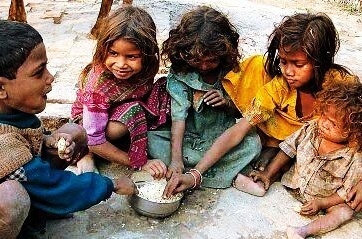Poverty In India EssayWhen a person or a group lacks the financial means and daily necessities necessary for a quality of life, it is this situation which is referred to as poverty. In this instance, the necessities for a minimal level of existence are lacking. Because of their poor income, they cannot meet even their most basic needs in this circumstance. There are many factors contributing to India's extreme poverty. Still, in short, the population explosion, rising prices, debt trap, decreased agricultural production, and lack of adequate government development are the only ones. 
These elements have widened the wealth disparity and raised the amount of poverty. The wealthiest become more opulent while the poor keep getting impoverished. This has exacerbated the issue with the Indian economy. Poverty has an impact on the nation's economy as a whole, as well as on an individual, their family, or their neighbourhood. Overall, the Indian economy depends on output, and poverty reduces efficiency in such situations. Poverty: What Is It?Being severely poor is the definition of poverty for a person. In this state, the person begins to lack the necessities of life, such as a roof over their heads and the food, medicine, and clothing they need to survive. There could be several causes causing poverty. Low income and the inability to obtain the essential commodities and services required for a person to survive with dignity constitute poverty in India. The poor state of one's health and education are also included. It also includes limited access to sanitary facilities and clean water, insufficient physical safety, insufficient capability, and the chance to live a better life. One of India's most significant social problems now is poverty. A sizeable portion of the Indian population is negatively impacted. The rise in poverty in India is mainly due to population increase, emigration to cities in pursuit of employment, and widespread unemployment. Some of the ways that poverty can be somewhat reduced include raising the literacy rate and giving the poor sustainable living conditions. India's Poverty SituationIndia is one of the biggest democratic nations in the world, and its economy is expanding more quickly. It is a leading developing country with significant global significance. But it is still regarded as a developing nation. Poverty is one of every country's biggest problems, especially in India. A sizable portion of the population in India lives in poverty. It is an impoverished country as a result of this. Even 75 years after gaining our freedom, we still have difficulties, and poverty has afflicted our country. India has an extremely high rate of poverty, which has an impact on its progress. Many commercial and public sector organisations have successfully worked with the federal and state governments to address this issue. Their main goal is to abolish poverty in India entirely. Together, they have been able to implement some effective programs to partially eradicate this severe issue and maintain the happiness of their inhabitants. Every person's basic needs are being met to the best of their ability. This work has not reduced India's poverty. India is currently in its worst position in history, and it cannot be resolved by taking anything at face value. Understanding the character of Indian politics in the framework of history is so crucial. We can therefore find policies that could be put into place to stop this societal ill. India's Poverty: Its RootsThe growing population exacerbates the issue of bad agricultural practices. In addition, wealth is not distributed equally. As a result, the wealthier neighbourhood frequently takes advantage of the underprivileged. Poor farming practices, a growing population, the gap between the rich and the poor, corruption, and black money are the main factors contributing to India's poverty.
Effects of Poverty
How Can India Reduce Poverty?The issue cannot be fixed in a week or a year. In order to implement some of the measures that assist the population living below the poverty line, the government of the nation must plan carefully. The other two causes of poverty in India are illiteracy and unemployment. Only with appropriate education and financial support can this problem be solved. Access to education can encourage higher education, and more education can make such people more employable. In this way, as the person begins to earn money, poverty may increase. In India, education is the most potent weapon against poverty. India's most effective tool against poverty is education. The following actions are required to eradicate poverty in India: The GOI ought to spend on reducing poverty there.
ConclusionThe difficulty of poverty is that those who experience it are unable to obtain even the most basic necessities of life. The government and other NGOs have taken many actions to lessen poverty. Therefore, the quality of life outside of India can be raised.
Next TopicSardar Vallabhbhai Patel Essay
|
 For Videos Join Our Youtube Channel: Join Now
For Videos Join Our Youtube Channel: Join Now
Feedback
- Send your Feedback to [email protected]
Help Others, Please Share










